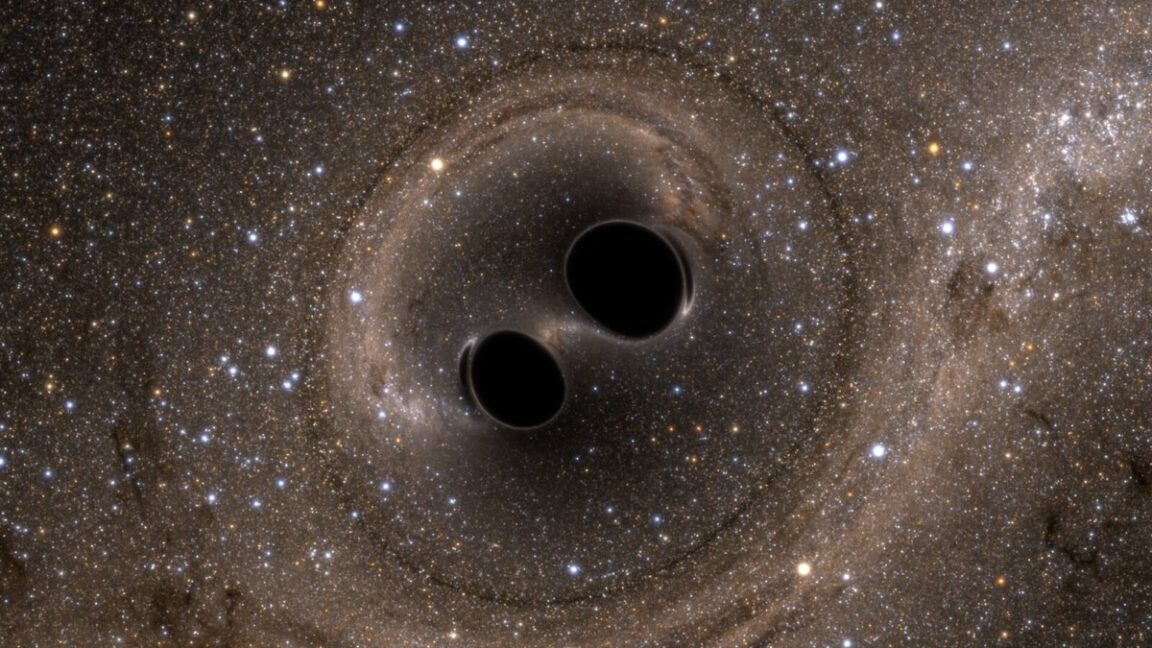Science
Physicists Detect Record-Breaking Black Hole Merger

A groundbreaking discovery has emerged from the field of astrophysics as physicists with the LIGO/Virgo/KAGRA collaboration detected a gravitational wave signal known as GW231123. This signal marks the most massive merger of two black holes ever observed, resulting in a new black hole that is an astonishing 225 times more massive than our Sun. The findings were presented at the Edoardo Amaldi Conference on Gravitational Waves held in Glasgow, Scotland.
The LIGO/Virgo/KAGRA collaboration is dedicated to searching for gravitational waves produced by the mergers of black holes and neutron stars. The detection process involves advanced laser interferometry techniques. High-powered lasers measure minute changes in the distance between two objects located kilometers apart, enabling scientists to capture the fleeting signals of cosmic events. LIGO operates two detectors in the United States, one in Hanford, Washington, and another in Livingston, Louisiana. Additionally, the Advanced Virgo detector in Italy has been active since 2016, and KAGRA in Japan is the first gravitational-wave detector in Asia, notable for its underground construction. A new facility, LIGO-India, began construction in 2021 and is expected to be operational after 2025.
Since its inception, the collaboration has successfully detected dozens of merger events, including the initial discovery that earned the Nobel Prize in Physics. Early detections primarily involved mergers of either two black holes or two neutron stars. Notably, in 2021, the collaboration confirmed two separate “mixed” mergers, involving black holes and neutron stars. The fourth observing run commenced in 2023, leading to the announcement of a significant signal indicative of a merger involving two compact objects—one likely a neutron star and the other an intermediate mass object, heavier than a neutron star but lighter than a black hole. This detection suggested that the mass gap might not be as empty as previously believed.
Prior to this discovery, the most massive merger recorded was GW190521, which took place in 2020 and resulted in a black hole approximately 140 times the mass of our Sun. The newly detected merger, GW231123, surpasses its predecessor, with the merging black holes estimated to be around 100 and 140 solar masses respectively. The announcement of this discovery took longer than usual due to the rapid spinning of the black holes involved, which approached the limits defined by the general theory of relativity, complicating the signal interpretation.
This finding is significant not only for its record-breaking mass but also for its implications on current theories of stellar evolution. The progenitor black holes are too massive to have formed from a typical supernova explosion. Similar to GW190521, GW231123 may exemplify a “hierarchical merger,” indicating that the two black holes were previously formed from earlier merger events before merging again.
Ed Porter, a physicist with CNRS in Paris, noted, “The discovery of such a massive and highly spinning system presents a challenge not only to our data analysis techniques but will have a major effect on the theoretical studies of black hole formation channels and waveform modeling for many years to come.” The findings from the LIGO/Virgo/KAGRA collaboration continue to reshape our understanding of the universe, revealing complexities in black hole formation and the nature of cosmic events.
-

 World5 months ago
World5 months agoSBI Announces QIP Floor Price at ₹811.05 Per Share
-

 Lifestyle5 months ago
Lifestyle5 months agoCept Unveils ₹3.1 Crore Urban Mobility Plan for Sustainable Growth
-

 Science4 months ago
Science4 months agoNew Blood Group Discovered in South Indian Woman at Rotary Centre
-

 World5 months ago
World5 months agoTorrential Rains Cause Flash Flooding in New York and New Jersey
-

 Top Stories5 months ago
Top Stories5 months agoKonkani Cultural Organisation to Host Pearl Jubilee in Abu Dhabi
-

 Sports4 months ago
Sports4 months agoBroad Advocates for Bowling Change Ahead of Final Test Against India
-

 Science5 months ago
Science5 months agoNothing Headphone 1 Review: A Bold Contender in Audio Design
-

 Top Stories5 months ago
Top Stories5 months agoAir India Crash Investigation Highlights Boeing Fuel Switch Concerns
-

 Business5 months ago
Business5 months agoIndian Stock Market Rebounds: Sensex and Nifty Rise After Four-Day Decline
-

 Sports4 months ago
Sports4 months agoCristian Totti Retires at 19: Pressure of Fame Takes Toll
-

 Politics5 months ago
Politics5 months agoAbandoned Doberman Finds New Home After Journey to Prague
-

 Top Stories5 months ago
Top Stories5 months agoPatna Bank Manager Abhishek Varun Found Dead in Well









